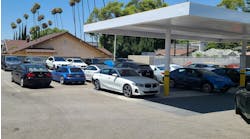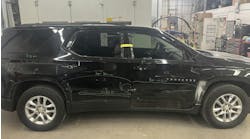Collision repairers need to know all the methods used as welding technology continues to evolve
The repair of collision-damaged vehicles has always involved the welding of sheet metal. However, the process for doing this has continuously evolved and changed throughout the history of collision repair.The first welding repairs were done with oxyacetylene welding equipment. Exterior body panels were welded with a steel rod and gas torch. This welding process produced a large heat-affect zone, but worked well on vehicles whose body panels were constructed of the heavier gauge mild steel that was used at the time.
However, changing technologies in the way vehicles were built led to a change in the welding process used to repair them. Fuel mileage became a design consideration for vehicles in the 1970s and to address this, unibody construction became the norm. Thinner, higher-strength steels also began to be used. The large heat-affect zone created by gas welding caused warping of thinner panels, and worse yet, compromised the strength of the newer high-strength steels being used.
Unibody vehicles are typically constructed at the factory with squeeze-type resistance spot welds (STRSW). The STRSW welding equipment used by the vehicle maker is very large and not practical for use in a collision repair facility. STRSW welding equipment was typically industrial and not geared for collision repair. The first STRSW welders available to the collision repair industry were small hand-held units that typically did not have the power necessary to produce quality welds in all areas and applications. Access for the welding tips to both sides of the panels being welded also was not possible in all areas.Because of these issues, a new welding process was needed for collision repairs and GMA (MIG) welding soon became the recommendation of the vehicle makers. The GMA (MIG) welding process has many advantages for collision repair. It produces a relatively small heat-affect zone, is a faster process than gas welding, welding equipment is compact and easy to move, and the process is not difficult to master. Typically a technician can produce quality GMA (MIG) welds after only a few hours of instruction and practice. GMA (MIG) welders can make plug welds for replacing factory spot welds, and seam welds for sectioning joints and other applications.
Future Trends
Fast forward to today and things are changing again. Aluminum is being used more and more on today's vehicles, both for structure and exterior body panels. Steels are changing at a dizzying rate. There are more different kinds and strengths of steel being used every day. Galvanizing of steel body parts is common for corrosion protection. GMA (MIG) welding is still a commonly used and recommended welding process for collision repairs, but recent advances in the STRSW equipment available to the field have led to it being recommended by many vehicle makers for welding on both exterior panels and structural parts. Like GMA (MIG) welding, the STRSW process can be learned quickly. It is one of the fastest welding processes available, has a very small heat-affect zone, and produces welds that have a factory appearance without the need for dressing. STRSW welders also do not produce the welding sparks that GMA (MIG) welding does, which can mean there is less of a need for disassembly of interior trim.A typical collision repair facility today is equipped with both GMA (MIG) and STRSW welding equipment. What does the future hold for collision repair welding? Only time will tell, but here's a glimpse into what may be coming. GMA (MIG) brazing, an adhesion rather than a fusion process, is starting to be used for collision repairs in Europe. Once thought of as only viable for cosmetic applications, such as filling joints and seams, GMA (MIG) brazing is now being used for some structural applications. In fact, the European automaker Vauxhall recommends GMA (MIG) brazing as the only joining method for collision repairs, both structural and nonstructural. GMA (MIG) brazing melts only the filler metal (silicon bronze) and not the surrounding metal in the weld zone. MIG brazing temperatures are between 960–1,000 degrees C (1,760– 1,830 degrees F), much lower than the approximately 1,650 degrees C (3,000 degrees F) of a GMA (MIG) weld. This lower temperature does not burn away the zinc corrosion protection (galvanizing), and does less heat damage to high-strength steel in the weld zone.
GMA (MIG) Welding
Let's look at the GMA (MIG) welding process and how it applies to welding sheet metal. With GMA (MIG) welding, the electrode wire, or filler metal, is deposited in the weld puddle by one of three means, short-circuit transfer, globular transfer or spray-arc transfer. The short-circuit transfer method, which gives that classic bacon frying sound, is the preferred method for welding on sheet steel because it uses thinner welding wire, lower voltage and amperage, and thus less heat when compared to the other transfer methods. Aluminum, because it transfers heat away for the weld so rapidly, is typically welded with the higher amperage and voltage spray-arc transfer method. Many vehicle makers are recommending that pulsed-spray transfer be used on aluminum. The pulsed-spray transfer method is a modified form of spray-arc transfer where the welding current is pulsed on and off instead of remaining constant throughout the weld. For this article, we are going to concentrate on the welding of sheet steel using short-circuit transfer.GMA (MIG) welding converts electrical energy into heat, which melts the base metal and the electrode filler wire. The amount of heat put into the weld is a function of the voltage and amperage outputs of the welding machine. The amperage output is what primarily controls the heat put into a weld. The amount of amperage required to make a weld is dependent on the thickness of the steel being welded (see chart). Amperage is adjusted by changing the wire speed. The output voltage controls the arc length and width, and the rate at which the electrode wire melts. The higher the voltage, the wider the arc and weld puddle will be at the base metal. Voltage and amperage settings must match each other. Too low of a voltage for the amperage selected will not melt the electrode wire as fast as it is being fed, resulting in electrode stubbing. Too much voltage will melt the wire faster than it is being fed and will result in electrode burn back into the tip. GMA (MIG) welding machines typically have charts that give recommended settings for voltage and amperage based on metal thickness. These charts can be used as a starting point for setting up the machine to make a weld.
Let's look at the electrode wire. The most commonly used electrode wire for collision repairs is ER70S-6. This is a solid electrode wire with a tensile strength of at least 70,000 psi. It works well for making welds in all positions, and has the best performance when welding over contaminants of any kind. ER70S-7, which has high amounts of manganese that adds to weld quality on zinc-coated steels, is another electrode wire that can be used for collision repairs, but its availability may be limited. Some vehicle makers may recommend the use of a different electrode wire for specific applications. ER70S-3 is recommended by some vehicle makers for welding sectioning joints on full frames. Flux-cored wire, which has an inner core of flux that protects the weld puddle from the atmosphere and other contaminants, is recommended by at least one vehicle maker for welding specific vehicle structures. The diameter of the electrode wire is selected based on the thickness of the material being welded, or the amperage required (see chart). The two most common electrode wire diameters for sheet metal welding are 0.6mm (.023-.025 inch) and 0.8mm (.030 inch).
A shielding gas is required to protect the weld puddle from atmospheric contamination during GMA (MIG) welding. The most common shielding gas used for collision repair welding of mild and high-strength steels is a mix of 75 percent argon and 25 percent CO2. Pure argon is typically used when welding aluminum and for GMA (MIG) brazing. Pure CO2 shielding gas is not recommended for collision repairs as it increases the heat affected zone and penetrates too deep on thin-gauge metal. Shielding gas flow rate is typically adjusted to 25-30 cfh for collision repair welding. Too low of a flow rate will not provide adequate protection and may result in weld porosity. Conversely, too high of a flow rate may actually pull contaminants into the weld puddle along with the shielding gas.Joint Preparation
Welding technique and joint preparation are just as important to the quality of a GMA (MIG) weld as is proper equipment, setup and consumables. Joint fit-up is the first step to a quality weld. A poor-fitting joint with large gaps will increase the probability of a substandard weld. Take the proper time to ensure that sectioning cuts are made accurately, and that flanges are straight and mate together tightly.
Proper joint cleaning is also critical. Welding over paint, rust or any other contaminants on the base metal will result in a porous weld that lacks penetration. The heat of the weld will be used up burning off the contaminant instead of melting the base metal. The vaporized contaminants will mix into the weld puddle, causing porosity in the weld bead. When cleaning the metal, try not to remove any galvanized coatings. Be sure not to reduce the thickness of the metal if using a grinder.
After cleaning of the base metal is finished, bare metal areas should be coated with a weld-through primer, unless its use is not recommended by the vehicle maker. After joint fit-up, the weld-through primer should be removed from the immediate weld zone before welding.
Welding Technique
With the metal properly cleaned, the joint tightly fit-up, and the welding machine set up according to the chart, it's time to make our welds, right? Well, not quite yet, since individual welding technique also can affect weld penetration and strength. Practice welds need to be made. Gun distance from the base metal will affect the electrical resistance and, therefore, the amperage output of the welding machine. Gun travel speed and angle also will affect both the penetration and shape of the weld bead. Making practice welds on the same type and thickness of metal, and in the same position that they will be welded on the vehicle, will allow the welding machine settings to be adjusted to your particular welding technique. Be sure to destructively test the practice welds to ensure that they have adequate strength.
Stick-out, or the distance from the end of the contact tip to the end of the electrode wire, affects the amperage output and, therefore, should be kept constant along the length of a weld. The shorter the stick-out length, the lower the resistance in the welding circuit and the higher the amperage output will be. This means shortening stick-out will increase weld bead penetration, and lengthening stick-out will decrease penetration. When welding with 0.6mm (.023–.025 inch) wire, stick-out should be in the 6–13 mm (¼ to ½-inch) range, and for 0.9mm (.035 inch), it should be 13–25 mm (½ to 1-inch).
Pushing a weld is when the welding gun is pointed and pushed away from the weld bead. This technique directs the heat away from the weld and produces a flatter, wider bead with less penetration. When welding thin metal where burn-through is an issue, using the push technique may be helpful. Pulling the weld is when the welding gun is pointed at and dragged away from the weld bead. This technique directs the heat of the arc at the preheated base metal and increases penetration while producing a higher, narrower bead. Aluminum GMA (MIG) welding requires the push technique to be used since it directs the shielding gas and arc heat at the base metal ahead of the weld. This produces an arc cleaning action that helps remove aluminum oxide from the surface.
Another variable is the welding gun angle. The angle is the direction at which the welding gun is aimed on the joint being welded. It also takes into consideration which of the two pieces of metal at which the electrode wire is aimed. This will depend on the joint type being welded and whether or not the two pieces are the same or different thicknesses. Plug welds and butt welds are typically made with the welding gun at a 90-degree angle to the joint.
For fillet welds on lap joints, the gun is typically aimed at a 45-degree angle to the joint. When both pieces are the same thickness, the electrode wire is aimed at the joint center or just slightly towards the bottom piece on lap joints. When the pieces are of different thicknesses, the electrode wire should be aimed off center towards the thicker piece.
Heat Management
Heat management is another important consideration when welding on sheet metal. Heat management is a combination of the welding machine settings, the total time that a weld is continuously made and the weld location. Too much heat when making one continuous weld or a series of plug welds causes distortions and weakens the base metal, and may cause weld burnthrough. Setting the voltage and amperage higher than necessary for a weld will not improve weld quality, but will increase the heat input and problems associated with that. Set the welding machine voltage and amperage only high enough to make a good weld at a comfortable travel speed.
Other welding techniques used to manage heat buildup include stitch welds, skip welds and alternating plug welds. A stitch weld is a continuous weld that is made in small segments, stopping briefly between welds to allow some cooling. Skip welds use a similar concept, only the small welds are skipped around on the joint and the spaces between are then filled in. The alternating plug weld technique involves skipping around on the flange when welding to avoid making two welds next to each other concurrently. This will help avoid making a plug weld in a location that has been preheated by a previous weld.
STRSW
As noted earlier, STRSW equipment has advanced to the point where it is now commonly used for collision repair welding of both exterior steel body panels and structural parts. Both the amperage output and available squeeze pressure at the welding tips has increased dramatically when compared to the first welders available. Access of the welding tips to both sides of the weld is about the only limitation to STRSW for repairing steel vehicles. Although specific procedures and applications may exist, resistance spot welding of aluminum during collision repairs is typically not recommended. The power supply of STRSW equipment used for collision repair welding should be 220V minimum and preferably 3-phase. An important consideration when using STRSW is the power available at the wall where the machine is plugged in. Wiring to the wall plug must be of adequate size to carry the amperage that the welding machine requires. Even the best equipment will not function properly if the source voltage and amperage are not adequate.
The general recommendation for replacing panels with STRSW is to use the same number of welds and the same spacing as the factory spot welds, but avoid the original location. STRSW welds are typically made next to the original factory spot welds. Flanges to be welded must be straight and clean. Remove any e-coat, paint finishes or other contamination from both sides of the flanges in the weld zone. Bare metal is typically coated with a weld-through primer — check the recommendations for the specific application being worked on. Tight fit-up of the two flanges being welded is necessary when making spot welds. Do not rely on the tips of the welding machine to pull the flanges together. Straighten the flanges so they fit snugly together and use clamps to hold them tight.
As with GMA (MIG) welding, practice welds should be made on the same type and thickness of metal that will be welded on the vehicle. The practice welds must be destructively tested to ensure that they are of adequate strength. Spot welds are typically destructively tested with a peel test. In a peel test, the upper piece is peeled off of the lower piece. A good weld will tear a hole in one piece and leave a weld nugget on the other. Vehicle makers may have charts specifying the minimum weld nugget diameter that is acceptable on different thicknesses of metal.
Weld Bonding
Weld bonding is a process that combines adhesive bonding with STRSW. Weld bonding may be used on quarter panels, roof skins, door skins and outer door opening rings (unisides). Weld bonding should only be done where a procedure exists or the part was originally attached with weld bonding. Most weld bonding procedures call for a specific adhesive, so be sure to use the adhesive recommended for the procedure being done. Weld-through primer is not used, as the bare metal on the flanges is completely coated with the adhesive. Weld bonding typically requires higher squeeze pressure at the welding machine tips than STRSW alone.
Welding sheet metal has always been an important part of collision repairs. As vehicles have changed, so has the welding technology used to repair them. Many procedures today are done using more than one type of welding equipment. Replacing a quarter panel may require STRSW welding along the door opening flanges, and around the wheel opening, and a GMA (MIG) seam weld at a sectioning location in the rocker panel or sail panel area. A few GMA (MIG) plug welds also may be required in areas where inner panels or reinforcements restrict access of the STRSW welding tips to both sides of the weld.



